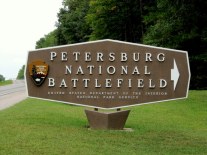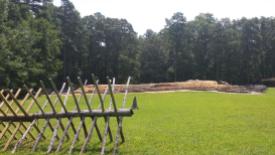During my trip to several Civil War battlefields this summer, one historical park stood out as distinctly different from the others. The Petersburg National Battlefield interprets the site of one of the Civil War’s longest contests, a prolonged siege featuring numerous small fights which mark the extended prelude to the frantic last campaign of Gen. Robert E. Lee’s Army of Northern Virginia. The fighting (and squalid conditions) along the lines at Petersburg in 1864-1865 resulted in some 70, 000 casualties, making it one of the deadliest—if not the most glamorous—clashes of the war. It famously pitted the remnants of the once-proud Confederate army, including some of the youngest and oldest Southern troops pressed into service, against a large and increasingly well-supplied Union army whose might made the outcome of the contest somewhat inevitable.
That fact, along with the remains of the earthworks constructed by the contending armies, brought the horror and desperation of the war home in a unique way. In place of a gallant charge, there was a huge hole where an underground mine was set off underneath a portion of the Confederate lines. In place of the proverbial old home where a general laid plans for battle there were piles of earth delineating the battle lines from which the contestants watched each other in a ceaseless vigil; those brave or foolish enough to expose themselves for a moment too long were shot down by sharpshooters. I could not help but ponder the terrible conditions the soldiers endured, and the desperation and nervousness each side must have felt as they wondered if every day would be the day that decided the contest—and by extension to some degree, the war. This is not to mention, of course, the apprehension with which the stalemate was monitored by civilians in the city of Richmond and Petersburg itself, communities whose fated hinged quite literally on what happened along the siege lines.
Visiting the park was an enlightening experience, and actually one of the better and more memorable I have had in any historical park. There were excellent reconstructions of the obstacles placed in front of the lines; realistic depictions of the gun emplacements and troop living conditions; an innovative—even if older—visitor center that interpreted the siege in profound terms with minimal text and artifacts; a good overview film; and an enthusiastic and informed staff that complemented all the park had to offer. Petersburg is a big park, and there is a lot to see. For those contemplating a visit, I would forewarn them that a tour will take a little time, and that they should be aware that a sizable portion of the remaining earthworks are actually detached from the main park tour route and not as easily accessible or as well interpreted as the main portion of the park. Petersburg may not be as familiar to the casual Civil War historian as, say, Gettysburg or Antietam, but I assure you it is worth to time to visit.
JMB







